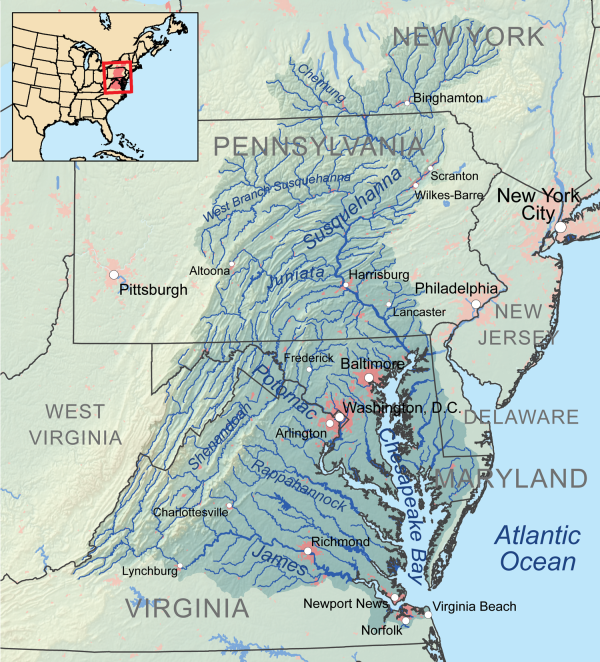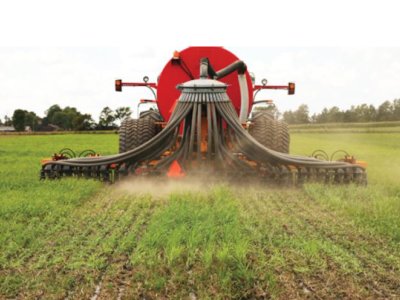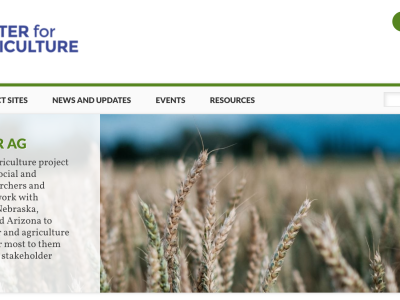Wherever you are reading this, you are a stakeholder of water quality within a local watershed. However, I imagine that many readers will be located within the Chesapeake Bay watershed, which is the largest estuary in the United States. Over 64,000 square miles of land within the watershed basin (approximately the size of Wisconsin) channel precipitation to the Chesapeake.
In the past several centuries since European colonization, there has been a noticeable decline in the water quality of the Bay due to changes in the landscape from practices such as deforesting, tilling the soil, and building mill dams. Today, there are multiple types of pollution that affect the Bay’s water quality. However, sediment, nitrogen, and phosphorus, which were identified in the 1980s as the causes of the Bay’s harmful algal blooms and turbid waters, persist as the predominant three pollutants of concern in Bay water quality modeling. Over the past several decades, the six states (and Washington, D.C.) in the Bay’s watershed have implemented strategies to address the sources of these pollutants. However, improvements to the Bay have been slow to show progress, and the states faced legal deadlines to achieve goals.

In 2019, the Pennsylvania Department of Environmental Protection (PADEP) rolled out a “local and specific” Countywide Action Plan (CAP) strategy to reduce its pollution burden on the Chesapeake Bay by 2025. Counties within the Chesapeake Bay watershed were encouraged to engage with local stakeholders to develop localized plans to achieve reduction goals for nitrogen, phosphorus, and sediment loads, which impair local waters and the Bay downstream. These goals were determined through data and modeling by the Chesapeake Assessment Scenario Tool (CAST).
While there are monitors, data, and models for water quality and contaminants, I was interested in studying the social processes of engagement and localized planning strategies. For my master's thesis in rural sociology, I wanted to see how counties across the Commonwealth engaged with local stakeholders and whether that engagement had an impact on the social and environmental outcomes achieved in those counties. Ultimately, I wondered whether the time, energy, and money put into engaging stakeholders would impact the ability to address water quality problems in local waters, local communities, and downstream.
My research showed that there were differences in how counties across the watershed worked with local people and groups. For example, some counties relied on their steering committee to make their plans with relatively little engagement of stakeholders beyond previously known contacts. Many counties focused on creating groups based on sectors such as agriculture or stormwater, engaging some new stakeholders in the planning process. A few counties with more staff and resources pursued broader methods to involve a diverse array of stakeholders in making their plans and going beyond CAP-specific boundaries.
The different approaches taken by the counties affected what they were able to achieve. While taking part in the engagement process had positive outcomes for all counties, those with engagement processes that utilized skilled facilitation and included participants with diverse perspectives were more likely to have achieved desirable outcomes, including:
- Increased awareness of water quality issues and their possible solutions,
- New and stronger partnerships, and
- Improved project prioritization protocols, among others.
The achievement of desired outcomes in the counties was enhanced by the timely availability of technical and financial resources, such as staff, contractors, consultants, and funding for engagement opportunities and projects. However, local capacity of county staff and stakeholders to apply for and manage funds and to collaborate with partners limited the successful outcomes of counties.
Another challenge that counties had to address was engaging stakeholders around the pre-defined nutrient reduction goals determined by the CAST model. A lack of clarity related to counties’ plans and expectations after the 2025 deadline constrained the engagement processes and achievement of desired outcomes because some stakeholders chose not to engage in a process with those parameters.
Significant efforts were undertaken to pursue stakeholder engagement at the county level. Those efforts took steps in the right direction. Based on these findings, I developed three recommendations for all the stakeholders of local water quality to implement:
- Collaborate: Build and strengthen collaborations with partners through opportunities to make connections and network,
- Build local capacity: Build and sustain local organizational capacity, especially by investing in developing facilitation skills and proactively incorporating the perspectives of diverse participants, and
- Account for co-benefits: Holistically account for the social and environmental co-benefits of processes and water quality projects.
If efforts to sustain local stakeholder engagement in water quality planning are continued, then I expect over time we will see improvements in our local waters and communities.
To learn more about stakeholder engagement, check out an IEE blog post by my advisor, Dr. Kathy Brasier.
Erin Trouba is a Penn State Extension educator who provides education, training, and technical assistance to conservation professionals and agricultural landowners implementing agricultural best practices within the Commonwealth of Pennsylvania.






